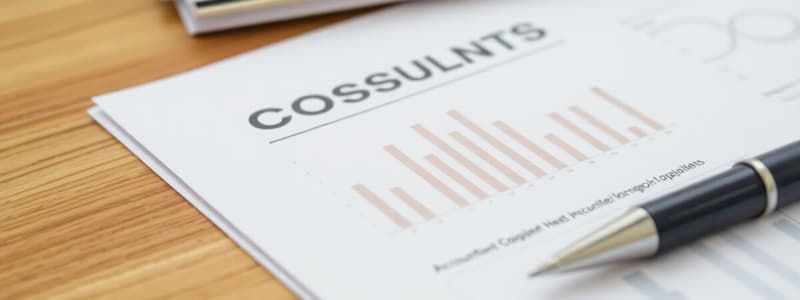Podcast
Questions and Answers
When a journal entry involves more than two accounts, it is best described as a what?
When a journal entry involves more than two accounts, it is best described as a what?
- Simple journal entry
- Compound journal entry (correct)
- Adjusting entry
- Erroneous journal entry
Which of the following combinations is NOT a possible outcome of a standard journal entry?
Which of the following combinations is NOT a possible outcome of a standard journal entry?
- Decrease in equity and increase in liability (correct)
- Increase in asset and increase in liability
- Increase in asset and decrease in equity
- Decrease in liability and decrease in asset
Which option best describes a chart of accounts?
Which option best describes a chart of accounts?
- An accounting manual
- A flowchart of all transactions
- A journal
- A list of all account titles in the general ledger (correct)
Temporary accounts are also commonly referred to as what?
Temporary accounts are also commonly referred to as what?
Which of the following accounts is NOT classified as a real account?
Which of the following accounts is NOT classified as a real account?
What is the accounting process of 'posting'?
What is the accounting process of 'posting'?
Which of the options defines a general ledger?
Which of the options defines a general ledger?
A listing of the components of individual account balances can be described as what?
A listing of the components of individual account balances can be described as what?
What is the primary purpose of the accounting cycle?
What is the primary purpose of the accounting cycle?
Which of the following sequences accurately represents the mandatory steps in the accounting cycle?
Which of the following sequences accurately represents the mandatory steps in the accounting cycle?
Why is the analysis of business transactions a crucial first step in the accounting cycle?
Why is the analysis of business transactions a crucial first step in the accounting cycle?
What is the role of a 'Journal' in the accounting process?
What is the role of a 'Journal' in the accounting process?
In which step of the accounting cycle are adjusting entries prepared?
In which step of the accounting cycle are adjusting entries prepared?
Which of the following activities takes place during the 'posting' step of the accounting cycle?
Which of the following activities takes place during the 'posting' step of the accounting cycle?
Which of the following is an optional step in the accounting cycle?
Which of the following is an optional step in the accounting cycle?
Why is it important to follow the steps in the accounting cycle in chronological order?
Why is it important to follow the steps in the accounting cycle in chronological order?
What is the primary purpose of adjusting entries at the end of an accounting cycle?
What is the primary purpose of adjusting entries at the end of an accounting cycle?
Which accounts are always involved in adjusting entries?
Which accounts are always involved in adjusting entries?
What is the effect of recording accrued expenses on the financial statements?
What is the effect of recording accrued expenses on the financial statements?
How does the recognition of accrued income impact a company's financial statements?
How does the recognition of accrued income impact a company's financial statements?
Which of the following describes the purpose of the 'Posting' process in accounting?
Which of the following describes the purpose of the 'Posting' process in accounting?
How is the book value (or carrying value) of an asset calculated?
How is the book value (or carrying value) of an asset calculated?
What type of account is 'Accumulated Depreciation'?
What type of account is 'Accumulated Depreciation'?
What is the primary purpose of a worksheet in accounting?
What is the primary purpose of a worksheet in accounting?
An accountant prepares a worksheet primarily to:
An accountant prepares a worksheet primarily to:
What is the primary purpose of closing entries?
What is the primary purpose of closing entries?
Which accounting concept is most closely associated with the closing of the books?
Which accounting concept is most closely associated with the closing of the books?
Reversing entries are primarily used to:
Reversing entries are primarily used to:
Which of the following is an example of an account that would likely be reversed?
Which of the following is an example of an account that would likely be reversed?
The purpose of reversing entries is to simplify the recording of some transactions. Which of the following scenarios would most benefit from the use of a reversing entry?
The purpose of reversing entries is to simplify the recording of some transactions. Which of the following scenarios would most benefit from the use of a reversing entry?
Which of the following accounts would not be closed during the closing process?
Which of the following accounts would not be closed during the closing process?
A company uses the expense method for prepaid expenses. At the beginning of the new accounting period, what type of entry would be needed if an adjusting entry was made for prepaid insurance at year-end?
A company uses the expense method for prepaid expenses. At the beginning of the new accounting period, what type of entry would be needed if an adjusting entry was made for prepaid insurance at year-end?
Flashcards
Accounting Cycle
Accounting Cycle
The steps or procedures used in recording transactions and preparing financial statements.
Transaction Analysis
Transaction Analysis
Analyzing business transactions or documents to understand their financial impact.
Journalizing
Journalizing
Recording transactions in the journal, showing debits and credits.
Posting
Posting
Signup and view all the flashcards
Unadjusted Trial Balance
Unadjusted Trial Balance
Signup and view all the flashcards
Adjusting Entries
Adjusting Entries
Signup and view all the flashcards
Financial Statements
Financial Statements
Signup and view all the flashcards
Closing Entries
Closing Entries
Signup and view all the flashcards
Accrued Expenses
Accrued Expenses
Signup and view all the flashcards
Accrued Income
Accrued Income
Signup and view all the flashcards
Depreciation
Depreciation
Signup and view all the flashcards
Accumulated Depreciation
Accumulated Depreciation
Signup and view all the flashcards
Book Value
Book Value
Signup and view all the flashcards
Worksheet
Worksheet
Signup and view all the flashcards
Accounting Worksheet
Accounting Worksheet
Signup and view all the flashcards
Closing Expenses
Closing Expenses
Signup and view all the flashcards
Closing Revenues
Closing Revenues
Signup and view all the flashcards
Closing Income Summary
Closing Income Summary
Signup and view all the flashcards
Closing Withdrawals
Closing Withdrawals
Signup and view all the flashcards
Reversing Entries
Reversing Entries
Signup and view all the flashcards
General Journal
General Journal
Signup and view all the flashcards
Compound Journal Entry
Compound Journal Entry
Signup and view all the flashcards
Chart of Accounts
Chart of Accounts
Signup and view all the flashcards
Temporary Accounts
Temporary Accounts
Signup and view all the flashcards
Real Accounts
Real Accounts
Signup and view all the flashcards
General Ledger
General Ledger
Signup and view all the flashcards
Subsidiary ledger
Subsidiary ledger
Signup and view all the flashcards
Ledger Function
Ledger Function
Signup and view all the flashcards
Study Notes
- The accounting cycle encompasses the steps and procedures for recording transactions and preparing financial statements.
- The accounting cycle implements the whole accounting process.
- The steps should be followed chronologically.
Steps in the Accounting Cycle:
- Analysis of business transactions or documents.
- Journalizing.
- Posting.
- Preparation of the unadjusted trial balance.
- Preparation of adjusting entries.
- Preparation of the financial statements.
- Preparation of closing entries.
- Preparation of post-closing trial balance.
- Preparation of reversing entries.
- The unadjusted trial balance, post-closing trial balance, reversing entries, and worksheet are optional steps.
- An entity must analyze the correct treatment when recording a transaction.
- In accounting, every transaction is recorded in an account, having two sides: DEBIT and CREDIT.
- The analysis of accounts for debit or credit recording occurs before the journal entry.
- A "Journal" serves as the "Book of Original Entry," where transactions are first recorded.
- Transactions recorded in a journal are then summarized in the ledger, known as the "Book of Final Entry."
- The summarization process in the ledger is called "Posting."
- After recording and summarizing transactions, the account has a running balance, forming the basis for the unadjusted trial balance.
- The unadjusted trial balance is adjusted with the prepared adjusting entries.
Adjusting Entries
- Adjusting Entries are made at the end of each accounting cycle.
- Adjusting entries split mixed accounts or update accounts.
- Adjusting entries allocate revenues and expenses between current and future periods.
- All adjusting entries involve at least one Balance Sheet (Real) account and one Income Statement (Nominal) account
Adjusting Entries Include:
Accruals:
- Divided into two types: accrued expenses and accrued income.
- Accrued expenses (also known as accrued liabilities) are expenses recorded before payment, recognized in the accounting period they’re incurred.
- The adjusting entry to record accrued expenses debits Expense and credits Payable.
- Accrued income is money earned in the ordinary course of business but not yet received or billed to the customer.
- The adjusting entry to record accrued income debits Receivable and credits Revenue.
Depreciation:
- Depreciation is a systematic allocation of cost over an asset's useful life.
- The adjusting entry to record depreciation debits Depreciation Expense and credits Accumulated Depreciation.
- Recording of depreciation is done on a regular basis (usually annually).
- Depreciation expense is charged against income for the current period.
- The accumulated depreciation account is a Contra Asset account, offsetting the related asset.
- The accumulated depreciation account balance shall be netted against the cost of the asset, known as the Book Value or Carrying Value.
Worksheet Preparation
- A worksheet is a multi-column sheet used by accountants to compile and summarize data for financial statement preparation.
- Accountants prepare a worksheet when adjustments are needed and financial statements are being prepared.
- Worksheets facilitate the preparation of financial statements.
Closing Process
- Closing Entries are made at the end of an accounting period.
- Closing Entries are completed after adjusting entries and financial statements to close nominal or all temporary accounts.
- Closing an account means reducing its balance to zero.
- Closing the books applies the PERIODICITY CONCEPT.
CLOSING ENTRIES include:
- Closing expenses to the income summary account.
- Closing revenues to the income summary account.
- Closing the income summary account to capital.
- Closing withdrawals to capital.
The Reversing Process
- Reversing Entries are made at the beginning of a new period.
- Reversing entries transfer all accrued and prepaid items established by adjusting entries to nominal accounts for recording transactions in the new period.
- The purpose is to simplify the recording of some transactions.
- Reversing entries are literally the reverse of the original entry.
REVERSING ENTRIES include:
- Accrued Expenses.
- Prepaid Expenses using the expense method.
- Accrued Income.
- Deferred Income using the income method.
Studying That Suits You
Use AI to generate personalized quizzes and flashcards to suit your learning preferences.




